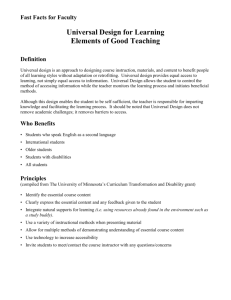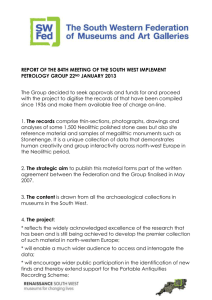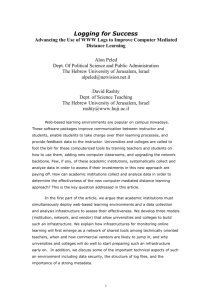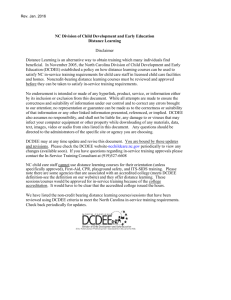Design pattern: attributes
advertisement
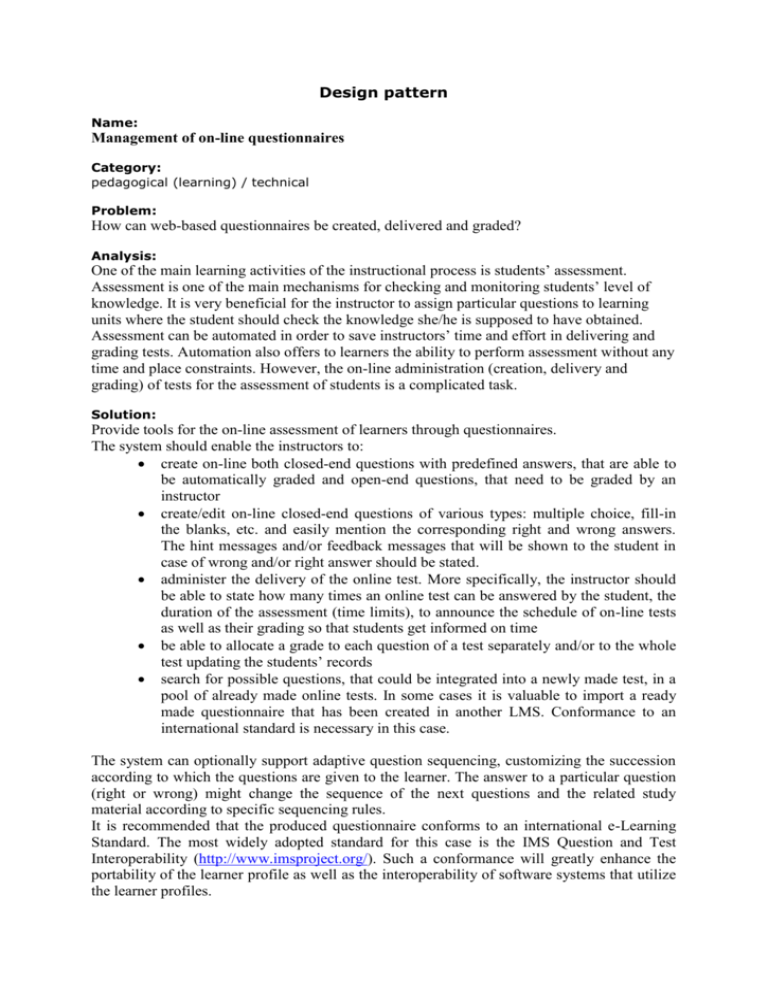
Design pattern Name: Management of on-line questionnaires Category: pedagogical (learning) / technical Problem: How can web-based questionnaires be created, delivered and graded? Analysis: One of the main learning activities of the instructional process is students’ assessment. Assessment is one of the main mechanisms for checking and monitoring students’ level of knowledge. It is very beneficial for the instructor to assign particular questions to learning units where the student should check the knowledge she/he is supposed to have obtained. Assessment can be automated in order to save instructors’ time and effort in delivering and grading tests. Automation also offers to learners the ability to perform assessment without any time and place constraints. However, the on-line administration (creation, delivery and grading) of tests for the assessment of students is a complicated task. Solution: Provide tools for the on-line assessment of learners through questionnaires. The system should enable the instructors to: create on-line both closed-end questions with predefined answers, that are able to be automatically graded and open-end questions, that need to be graded by an instructor create/edit on-line closed-end questions of various types: multiple choice, fill-in the blanks, etc. and easily mention the corresponding right and wrong answers. The hint messages and/or feedback messages that will be shown to the student in case of wrong and/or right answer should be stated. administer the delivery of the online test. More specifically, the instructor should be able to state how many times an online test can be answered by the student, the duration of the assessment (time limits), to announce the schedule of on-line tests as well as their grading so that students get informed on time be able to allocate a grade to each question of a test separately and/or to the whole test updating the students’ records search for possible questions, that could be integrated into a newly made test, in a pool of already made online tests. In some cases it is valuable to import a ready made questionnaire that has been created in another LMS. Conformance to an international standard is necessary in this case. The system can optionally support adaptive question sequencing, customizing the succession according to which the questions are given to the learner. The answer to a particular question (right or wrong) might change the sequence of the next questions and the related study material according to specific sequencing rules. It is recommended that the produced questionnaire conforms to an international e-Learning Standard. The most widely adopted standard for this case is the IMS Question and Test Interoperability (http://www.imsproject.org/). Such a conformance will greatly enhance the portability of the learner profile as well as the interoperability of software systems that utilize the learner profiles. Known uses: All LMS that were reviewed have some mechanism for on-line questionnaires. Context: This pattern is applicable to software engineering teams that develop Learning Management Systems. When implemented, its end-users shall be learners and instructors. References: 1. P. Avgeriou, A. Papasalouros, S. Retalis, Manolis Skordalakis, “Towards a Pattern Language for Learning Management Systems”, ΙΕΕΕ Educational Technology & Society, Volume 6, Issue 2, pp. 11-24, 2003. 2. P. Avgeriou, A. Papasalouros, S. Retalis, “Patterns For Designing Learning Management Systems”, proceedings of the European Pattern Languages of Programming (EuroPLOP) 25th–29th June 2003, Irsee, Germany. Related patterns: Assignments management, Student tracking. Author (s): P. Avgeriou, S. Retalis, A. Papasalouros Date: 29/1/2003



